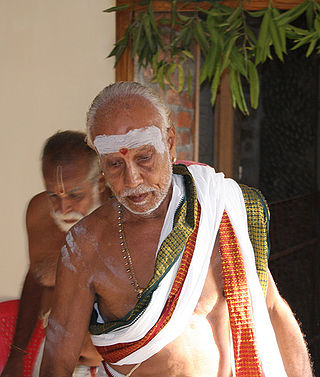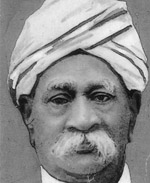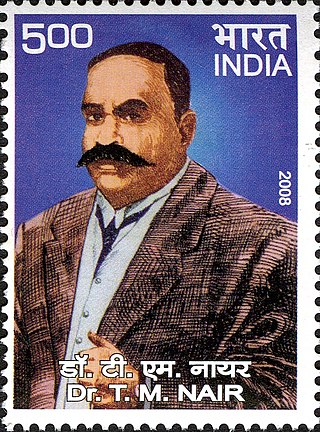Related Research Articles

Iyers are an ethnoreligious community of Tamil-speaking Hindu Brahmins. Most Iyers are followers of the Advaita philosophy propounded by Adi Shankara and adhere to the Smarta tradition. This is in contrast to the Iyengar community, who are adherents of Sri Vaishnavism. The Iyers and the Iyengars are together referred to as Tamil Brahmins. The majority of Iyers reside in Tamil Nadu, India.

The Dravida Munnetra Kazhagam is a political party based in the state of Tamil Nadu where it is currently the ruling party having a comfortable majority without coalition support and the union territory of Puducherry where it is currently the main opposition.
The Justice Party, officially the South Indian Liberal Federation, was a political party in the Madras Presidency of British India. It was established on 20 November 1916 in Victoria Public Hall in Madras by Dr C. Natesa Mudaliar and co-founded by T. M. Nair, P. Theagaraya Chetty and Alamelu Mangai Thayarammal as a result of a series of non-Brahmin conferences and meetings in the presidency. Communal division between Brahmins and non-Brahmins began in the presidency during the late-19th and early-20th century, mainly due to caste prejudices and disproportionate Brahminical representation in government jobs. The Justice Party's foundation marked the culmination of several efforts to establish an organisation to represent the non-Brahmins in Madras and is seen as the start of the Dravidian Movement.

Seshadri Srinivasa Iyengar CIE, also seen as Sreenivasa Iyengar and Srinivasa Ayyangar, was an Indian lawyer, freedom-fighter and politician from the Indian National Congress. Iyengar was the Advocate-General of Madras Presidency from 1916 to 1920. He also served as a member of the bar council from 1912 to 1920, the law member of Madras Presidency from 1916 to 1920 and as the president of the madras province Swarajya Party faction of the Indian National Congress from 1923 to 1930. Srinivasa Iyengar was the son-in-law of renowned lawyer and first Indian Advocate-general of Madras, Sir Vembaukum Bhashyam Aiyangar. Iyengar's followers called him Lion of the South.
Anti-Brahminism is a term used in opposition to caste-based hierarchical social order which places Brahmins at its highest position. Initial expressions of Anti-Brahminism emerged from instances of pre-colonial opposition to the caste system in India, ideological influences during the colonial period, and from a colonialist Protestant Christian understanding of religion in the 19th century, which viewed "Brahminism" as a corrupted religion imposed on the Indian population. Reformist Hindus, and also Ambedkar, structured their criticism along similar lines following the 19th century criticism of "Brahminism," opposing the dominant position Brahmins had acquired by the time of British rule in the 19th century.

Bollini Munuswamy Naidu was the Chief Minister of Madras Presidency from 27 October 1930 to 4 November 1932. He was conferred 'Rao Diwan Bahadur' by British Government.

Raja Sir Panaganti Ramarayaningar KCIE, also known as the Raja of Panagal, was a zamindar of Kalahasti, a Justice Party leader and the Chief Minister or Premier of Madras Presidency from 11 July 1921 to 3 December 1926.
Dravida Nadu is the name of a proposed sovereign state demanded by the Justice Party led by the founder of the self-respect movement, E.V. Ramasamy Periyar, and the Dravida Munnetra Kazhagam (DMK) led by C. N. Annadurai for the speakers of the Dravidian languages in South India.

Sir Pitti Theagaraya ChettyKCSI was an Indian lawyer, industrialist and a prominent political leader from the erstwhile Madras province. He was one of the founders of the Justice Party in 1916 along with C. Natesa Mudaliar, Dr. T. M. Nair. Theagaraya Nagar is a locality in Chennai which is named after him. On 1919 January 1, the title Dewan Bahadur was awarded to him
Dravidian parties include an array of regional political parties in the state of Tamil Nadu, India, which trace their origins and ideologies either directly or indirectly to the Justice Party and the Dravidian movement of C. Natesanar and Periyar E. V. Ramasamy. The Dravidian movement was based on the linguistic divide in India, where most of the Northern Indian, Eastern Indian and Western Indian languages are classified as Indo-Aryan, whereas the South Indian languages are classified as Dravidian. Dravidian politics has developed by associating itself to the Dravidian community. The original goal of Dravidian politics was to achieve social equality, but it later championed the cause of ending the domination of North India over the politics and economy of the South Indian province known as Madras Presidency.

Erode Venkatappa Ramasamy, revered as Periyar or Thanthai Periyar, was an Indian social activist and politician who started the Self-Respect Movement and Dravidar Kazhagam. He is known as the 'Father of the Dravidian movement'. He rebelled against Brahminical dominance and gender and caste inequality in Tamil Nadu. Since 2021, the Indian state of Tamil Nadu celebrates his birth anniversary as 'Social Justice Day'.

Taravath Madhavan Nair was an Indian politician and political activist of the Dravidian Movement from the Madras Presidency. He founded the Justice Party along with Theagaraya Chetty and C. Natesa Mudaliar.

Dr. C. Natesa Mudaliar (1875–1937), also known as Natesan, was an Indian politician and activist of the Dravidian Movement from what is now the Indian state of Tamil Nadu. He was one of the founders of the Justice Party, along with P. Theagaraya Chetty and Dr. T. M. Nair. He is often mentioned as Dravida Thanthai.

The first legislative council election to Madras Presidency after the establishment of dyarchical system of government by the Government of India Act 1919, was held in November 1920. Indian National Congress boycotted the election due to its participation in the Non-cooperation movement. The election occurred during the early stages of non-Brahmin movement and the major issue of the election was anti-Brahminism. Justice party won the election with no significant opposition and A. Subbarayalu Reddiar became the first Chief Minister of the presidency.

The third legislative council election to Madras Presidency after the establishment of dyarchical system of government by the Government of India Act, 1919, was held in November 1926. Justice party lost the election to Swaraj Party. However, as the Swaraja Party refused to form the Government, the Governor of Madras set up an independent government under the leadership of P. Subbarayan and with the support of nominated members.

The second legislative council election to Madras Presidency after the establishment of diarchical system of government by the Government of India Act, 1919 was held in 1923. Voter turnout was higher than the previous election. Swarajists, a breakaway group from Indian National Congress participated in the election. The ruling Justice Party had suffered a split, when a splinter group calling themselves anti-Ministerialists left the party. It won the highest number of seats but fell short of a majority. Nevertheless, Madras Governor Willington invited it to form the government. Incumbent Justice chief minister Panagal Raja was nominated by party leader Theagaraya Chetty to continue as chief minister for a second term. The government survived a no-confidence motion, brought against it on the first day of its tenure by the opposition headed by C. R. Reddy.
The Anti-Hindi imposition agitation of 1937–40 is a series of protests that happened in Madras Presidency of the British Raj during 1937-40. It was launched in 1937 in opposition to the introduction of compulsory teaching of Hindi in the schools of the presidency by the Indian National Congress government led by C. Rajagopalachari (Rajaji). This move was immediately opposed by E. V. Ramasamy (Periyar) and the opposition Justice Party. The agitation, which lasted for about 30 months, was multifaceted and involved fasts, conferences, marches, picketing and protests. The government responded with a crackdown resulting in the death of two protesters and the arrest of 1,198 persons including women and children. The mandatory Hindi education was later withdrawn by the British Governor of Madras Lord Erskine in February 1940 after the resignation of the Congress government in 1939.
Tamil Renaissance refers to the literary, cultural, social reform and political movements that took place in the Tamil-speaking districts of Southern India starting in the second half of the 19th century and lasting to the culmination of the anti-Hindi agitations of the 1960s.
Madras Presidency Association was a faction within the Indian National Congress which existed before indian independence. While Justice Party championed the cause of non-Brahmins in Madras presidency, non-Brahmins within the Congress party founded Madras Presidency Association (MPA).
S. Ramanathan was an Indian politician who served as the minister of Madras Presidency in the Congress-led government of 1937. He was the first founder of the Self-Respect Movement.
References
- ↑ Joshua Fishman; Ofelia Garcia (2010). Handbook of Language and Ethnic Identity:The Success-Failure Continuum in Language and Ethnic Identity Efforts (Volume 2): The Success-Failure Continuum in Language and Ethnic Identity Efforts. Oxford University Press, USA. pp. 230–. ISBN 978-0-19-539245-6 . Retrieved 7 July 2016.
- ↑ "A century of reform The Dravidian movement has left its progressive imprint on Tamil Nadu". Manuraj Shunmugasundaram. The Indian Express. 22 November 2016. Retrieved 8 August 2018.
- ↑ "The Inner Grammar Of Dissent Lives". K.S. Chalam. Outlook India. 12 December 2016. Retrieved 8 August 2018.
- 1 2 Irschick 1969 , pp. 1–26
- ↑ Myron Weiner and Ergun Ozbudun (1987). Competitive elections in developing countries. American Enterprise Institute. p. 61. ISBN 0-8223-0766-9.
- ↑ K. Nambi Arooran (1980). Tamil renaissance and Dravidian nationalism, 1905–1944. p. 37.
- ↑ Rajaraman 1988 , ch. 2 (The Genesis of the Justice Party)
- ↑ Irschick 1986 , pp. 30–31
Works cited
- Irschick, Eugene F. (1969). Political and Social Conflict in South India; The non-Brahmin movement and Tamil Separatism, 1916–1929. University of California Press. OCLC 249254802.
- Irschick, Eugene F. (1986). Tamil revivalism in the 1930s (PDF). Madras: Cre-A. OCLC 15015416. Archived from the original (PDF) on 10 June 2010. Retrieved 4 March 2010.
- Rajaraman, P. (1988). The Justice Party: a historical perspective, 1916–37. Poompozhil Publishers. OCLC 20453430. Archived from the original on 21 July 2011.